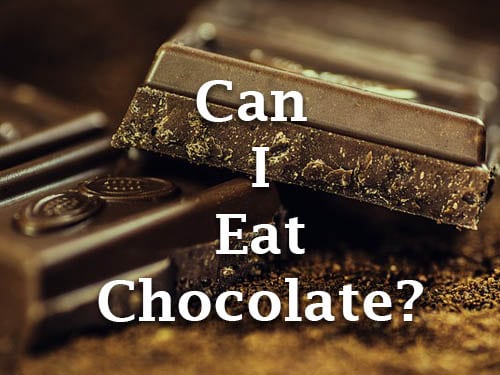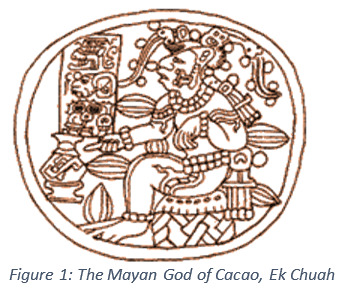Easy Read Good and Bad of Chocolate

Ohhhhhhhhhh….Chocolate!
Chocolate! How many times have you just had that sometimes nearly overwhelming urge to have some chocolate—in any form! You can have a chocolate bar, chocolate milk, chocolate cake, brownies, a chocolate ice cream sundae or a cup of hot cocoa just to list a few forms of chocolate. Oh wait—you can have dark chocolate, milk chocolate, orange, mint or raspberry-flavored chocolate or white chocolate….so much to choose from! But….should you? And if you should, just how much is enough and how much is overdoing it? Are there "healthier" forms of chocolate? Many of us sure as shootin' hope there is!
The "Dark" History of Chocolate

Chocolate comes from the fruit and seeds of the cacao tree and is native to the Amazon forest. Botanically, the cacao tree is known as Theobroma cacao – this tree has three major varieties; the Forastero, the Trinitario and the Criollo. The Forastero is the most commonly used variety while the rarest and most prized for its aroma and its delicate taste is the Criollo variety.
Christopher Columbus is credited with being the first European to come in contact with the cacao bean—he and his crew found—and stole, apparently—a canoe filled with various food items, including baskets of cacao beans. The cacao beans were actually used as local currency, but their chocolate quality was missed for another twenty years until Hernando Cortez brought 3 chests of cacao beans, this time stolen from the Aztecs, back to the court of the Spanish king—and the popularity of cacao and chocolate took off![1]
The history of chocolate though, actually appears to be much older, going back to at least the Mayan civilization and possibly the Olmec civilization that predates the Mayan civilization. The traditional chocolate beverage was made with water or wine and could be flavored with vanilla, pimento or chilli peppers. Cortez called the drink xocoatl and translated this as the "drink that builds up resistance and fights fatigue."
At roughly the same time that chocolate was "discovered" by Europeans, sugar use was beginning, and the various flavorings were replaced with sugar. The slave-driven plantations of the French, Spaniards, English and Dutch were soon producing chocolate for use as the increasingly popular beverage. Soon, though, chocolate was being used in baking. A Dutch chocolate maker, Conrad Van Houten patented a method of extracting and producing a cacao "cake" which could be easily powdered and then transported. In 1849, an English chocolate maker named Joseph Storrs Fry who produced, essentially, the first chocolate bar. The Swiss chocolate maker Daniel Peter added powdered milk – developed by the Swiss chemist Henri Nestlé—to cacao powder and created milk chocolate! Another Swiss chocolatier, Rudolphe Lindt invented a process that added smoothness to the chocolate. If you are a real chocolate aficionado, you probably recognize many of these names as marking some of the world's most famous and often best chocolate even today!
What is the Difference Between Dark, White and Milk Chocolate?
Dark chocolate is much closer to the original chocolate—the percentages such as 35%, 55% and 78% represent the amounts of cacao powder solids and cacao butter—the higher the percentage, the darker, the purer and the less sweet the chocolate. White chocolate is the cacao butter—the fatty and oily part of the cacao bean—mixed with sugar and milk. Milk chocolate is make with cacao solids along with sugar and either milk powder, liquid milk or condensed milk. [2]
According to the Fine Chocolate Industry Association, dark chocolate should not contain any ingredients beyond cacao liquor, sugar, cocoa butter, lecithin, and vanilla.[3] However, they also mention that a higher percentage chocolate does not necessarily indicate high quality—as with everything else, let the buyer beware! Stick with well-known, reputable companies or smaller artisan chocolatiers who value quality in their products!
What are the Health Benefits of Dark Chocolate?
The most important thing to understand about the health benefits of chocolate is that they only apply to dark chocolate—and the higher the %age of dark chocolate, the better the health benefits! Sad, perhaps, but definitely true.
That is the tough truth for those of us who love milk chocolate—these benefits really only apply very minimally to either milk chocolate or white chocolate. Tough cacao beans, but there it is!
The following are some of the proven benefits of dark chocolate (at least 70% cacao).
- Nutrition[4]
- 1 ounce of dark chocolate contains (70-85%)
-
-
- Total carbohydrate: 13 grams
- 7 grams of sugar
- 3 grams of dietary fiber
- 168 calories (108 calories from fat)
- 2 grams of protein
- Glycemic load: 4
- 9.5 mg of omega 3 fatty acids and 341 mg of omega-6 fatty acids
- Most of the fats are saturated or monounsaturated
- 19% of the Daily value (DV) for Iron
- 16% of the DV for Magnesium
- 25% of the DV for Copper
- 27% of the DV for Manganese
- Some potassium, phosphorus, zinc and selenium
- 22.4 mg of caffeine and 225 mg of theobromine (a substance similar to caffeine)
- Total carbohydrate: 13 grams
-
- Dark chocolate is an excellent source of antioxidants. Antioxidants can help prevent the damage caused by oxidative stress and it is believed that chronic diabetes of any type is a disorder of oxidative stress.
- The high levels of sugar in the blood bathe the cells in high levels of sugar—these high levels of sugar act as a toxin on the cells (especially nerve cells) and increases the production of substances called free radicals. These free radicals are very damaging to the internal contents of cells and are the cause of oxidative stress. Antioxidants work by soaking up these free radicals and preventing the free radicals from damaging the cell.
- When scientists determine the antioxidant content of a food, the measurement used is ORAC (Oxygen Radical Absorbance Capacity). One ounce of dark chocolate has an ORAC of 5903. [5] Without going into too much detail, that is high! As a comparison, 1 ounce of cranberry juice (100%) which is considered relatively high in antioxidants has an ORAC of about 216. One ounce of artichokes has an ORAC of 2354.
- The antioxidants in dark chocolate include flavanols, catechins, among others.[6]
- The flavanols in dark chocolate can stimulate the blood vessels to form nitric oxide, NO, which helps relax blood vessels—this can lower blood pressure and improve blood flow.[7]
- Dark chocolate increases HDL (GOOD) cholesterol and lowers LDL (BAD) cholesterol and lower the risk of heart disease.[8]
- Probably due to the caffeine and theobromine content, dark chocolate can help improve brain functions such as memory and cognition.
- Importantly for those with diabetes, dark chocolate can reduce insulin resistance.[9], [10]
- In a small study comparing white chocolate and 70% dark chocolate, those that ate 1.7 ounces of dark chocolate a day for 15 days had lower blood sugar levels, lower LDL levels and increased HDL levels. Insulin resistance was not measured.
How Much Dark Chocolate Should I Have?
As with so many other things, too much of a good thing is, well, too much! There is no commonly accepted "dosage" for dark chocolate. Dark chocolate does contain a lot of calories and a moderate amount of sugar. Make sure you include the chocolate in your carbohydrate count. Talk to your physician and your nutritionist for specific recommendations. In general, aim for about 1 ounce of dark chocolate 4-5 times a week. This is probably easiest to keep track of as solid chocolate, but you can also use about 4 ounces of baking chocolate and spread out the baked chocolate item over 4-5 days.
1 ounce of solid chocolate is equivalent to about 28 grams and 28 grams is equivalent to a bit over 5 ½ teaspoons, so you can also use 1 teaspoon of cacao powder in the evening to make a chocolate drink to relax with before you go to bed. Keep in mind, though, that cacao IS a stimulant and may not be the best thing to have right before bedtime!
So becareful but chocolate alternatives can be possible edible or be included in a diet.
TheDiabetesCouncil Article | Reviewed by Dr. Christine Traxler MD on June 03, 2020
Source: https://www.thediabetescouncil.com/the-benefits-of-chocolate-for-diabetes/
0 Response to "Easy Read Good and Bad of Chocolate"
Post a Comment